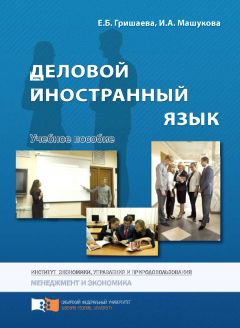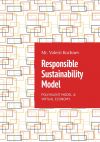Текст книги "Деловой иностранный язык"

Автор книги: Ирина Машукова
Жанр: Учебная литература, Детские книги
сообщить о неприемлемом содержимом
Текущая страница: 3 (всего у книги 15 страниц) [доступный отрывок для чтения: 4 страниц]
2. What losses were incurred by the Buyers?
3. What could be the Sellers’ position in the dispute?
4. Who has a real chance to win the case if the matter is submitted to Arbitration?
Roles
The Buyers’ side: Managing Director, Manager of the Finance and Currency Department.
The Sellers’ side: Chief Business Executive, Product Manager, Technical Expert.
Buyers
You represent the interests of the Russian Production Plant. You claim full compensation for the losses. The list of damages includes:
1. Part of the purchase price for the delivered equipment,
2. Projected transport charges back to the country of origin,
3. The fee to the Experts’ Commission.
You also claim the “lost profit”. Under Russian Law lost profit could be gained if the supplied equipment ran at s designed capacity. If your partner blocks the negotiation the only option left is to submit the case to Arbitration.
Tell your partner that you are ready to present
1. An Act of Experts’ Examination,
2. Chemical analysis of the content of steel.
During the negotiation you may refer to the Russian Civil (Code of the Article 219 entitles you to compensation).
Sellers
You represent the interests of the Suppliers.
During the talks you cannot deny poor operation of the equipment as finished products have visual defects. But you are dead sure that the only reason for malfunction is improper steel. You a| dead sure that poor quality steel affected the quality of the finished product.
In business you are always committed to a customer and your rescue plan may be:
1. To run a test with your own sample of steel used. It will help to discover the real fault.
2. To complete the commissioning of the full set of equipment. You will select people of better professional skills.
You may devise another plan. Just remember, that your main purpose is to dissuade your partners from rash actions.
Useful Language
Anything the matter?
The thing is …
Your claim should be supported by evidence.
That sounds reasonable.
There are complaints because…
There is also the problem of…
It came as a surprise.
It happened through no fault of ours.
Let’s split the expenses.
That’s just what we are going to suggest.
That seems fair.
Further Subjects for Discussion
An efficient business manager must know the law governing in a country where he runs his business. In business management it is a crucial point, especially when disputes arise.
How must a manager behave in a conflicting situation?
What are his rights by law?
Where can he apply for help?
These are the key questions to answer if you want expert management.
Exchange your opinions on the problem.
In this role play either of you should either agree or disagree with the arguments of the partner.
Table 3
Some useful hints on agreeing/disagreeing/saying you partly agree

Task 26. Writing 6
Write up the minutes of the meeting.
Task 27. Reading 9
Getting started
▪ Work in groups of three and discuss if there were any specialists in the past who run the business and their functions were similar to those of a present day manager.
▪ Can you think of a name for these specialists and their responsibilities? Were their duties the same or there were differences?
▪ Now skim the text, check your ideas.
▪ Consult Vocabulary p. 141.
THE PERSONAL MANAGER THROUGH HISTORY
1. The social reformer (19-th century)
He tried to intervene in industrial affairs to support the underprivileged factory worker at the hands of rapacious employer.
2. The welfare officer (late 19-th century)
He was appointed with specific responsibility for improving the lot of employees by dispensing benefits to deserving and unfortunate employees, in particular unemployment benefit, sick pay and subsidized housing.
3. The human bureaucrat
He was concerned with serving organizational as well as social ends. To meet the increasing size of companies and the specialization of management functions, the personnel manager’s role developed to take care of staffing, especially selection, training and placement.
4. The consensus negotiator (after the Second World War)
He had to develop expertise in bargaining in order to represent management’s interests more effectively in the face of the increasing strength of the trade union movement. The personnel manager sat on committees with union representatives to work towards consensus on matters affecting the workers’ conditions of service.
5. The organisation man (1960s)
He was concerned with the effectiveness of the organisation as a whole. The represented a move away from the inward focus of employer-employee relations to an outward focuses on the interaction between the people who make up the organisation and the surrounding society.
6. Manpower analyst
He is the manager of human resources. The trend towards quantifying all aspects of management has led to the view that human resources are a measurable resource that can be assessed, utilized and optimized to achieve the organisation’s goals.
Task 28. Talking Point 6
Work in groups of three, consult Speaking References p. 126–130 and discuss:
▪ Which of these six stereotypes do you find most attractive?
▪ Which best describes the work of the personnel department in your organisation?
Task 29. Talking Point 7
Read the situation below and act out the conversation between Jana and Dirk. Consult Speaking References p. 126–130.
Jana and Dirk talked about some of the main issues within Personnel Management and Human Resources Management. Although the two fields have many common areas, there is a substantive difference of emphasis.
Personnel Management is directed mainly at the organisation's employees. Although a management functions, it is never totally identified with management's interests.
Human Resources Management is directed mainly at management needs for human resources (not necessarily employees) to be provided and deployed. It is totally identified with management's interests and is relatively distant from the workforce as a whole.
Underpinning Personnel Management are the twin ideas that people have a right to proper treatment as dignified human beings while at work, and that they are only effective as employees when their job-related personal needs are met.
Underpinning Human Resources Management is the idea that the management of human resources is much the same as any other aspect of management, and getting the deployment of right numbers and skills at the right price is more important than interfering with people's personal affairs.
Task 30. Vocabulary 6
The box below contains a number of areas related to Personnel Management and Human Resources Management. Classify them according to their primary focus within these two areas.

Table 4

Unit 2. Company Structure
Learning outcomes
▪ Understand different types of organizing activities in a company, the functions they carry out, get to know about structures for organizations and decide which of them is the best for effective management
▪ Learn to study information presented in diagrams and support your talks with the information given in them
▪ Participate in discussions using your personal experience
Task 1. Reading 1
Getting started
▪ Before reading the text, discuss in small groups how many people must be responsible for the effective managing of the company? In what way should they inform the staff about important solutions, decisions, innovations, restructuring, etc.
▪ All organisations have this or that structure. Do you know anything about the structures? What are they? What are the principal differences between them?
▪ Discuss in groups of three how many departments can be in a big organisation and what they are responsible for. How is the work among departments organised?
▪ Read the text below about the different ways of organising companies, consult Vocabulary p. 142–143, and then label the diagrams, according to which of these they illustrate:

Figure 2
COMPANY STRUCTURE
Most organisations have a hierarchical or pyramidal structure, with one person or a group of people at the top, and an increasing number of people below them at each successive level. There is a clear line or chain of command running down the pyramid. All the people in the organisation know what decisions they are able to make, who their superior (or boss) is (to whom they report), and who their immediate subordinates are (to whom they can give instructions).
Some people in an organisation have colleagues who help them: for example, there might be an Assistant to the Marketing Manager. This is known as a staff position: its holder has no line authority, and is not integrated into the chain of command, unlike, for example, the Assistant Marketing Manager, who is number two in the marketing department.
Yet the activities of most companies are too complicated to be organised in a single hierarchy. Shortly before the First World War, the French industrialist Henry Fayol organised his coal-mining business according to the functions that it had to carry out. He is generally credited with inventing functional organisation. Today, most large manufacturing organisations have a functional structure, including (among others) production, finance, marketing, sales, and personnel or staff departments. This means, for example, that the production and marketing departments cannot take financial decisions without consulting the finance department.
Functional organisation is efficient, but there are two standard criticisms. Firstly, people are usually more concerned with the success of their department than that of the company, so there are permanent battles between, for example, finance and marketing, or marketing and production, which have incompatible goals. Secondly, separating functions is unlikely to encourage innovation.
Yet for a large organisation manufacturing a range of products, having a single production department is generally inefficient. Consequently, most large companies are decentralized, following the model of Alfred Sloan, who divided General Motors into separate operating divisions in 1920. Each division had its own engineering, production and sales departments, made a different category of car (but with some overlap, to encourage internal competition), and was expected to make a profit.
Businesses that cannot be divided into autonomous divisions with their own markets can simulate decentralization, setting up divisions that deal with each other using internally determined transfer prices. Many banks, for example, have established commercial, corporate, private banking, international and investment divisions.
An inherent problem of hierarchies is that people at lower levels are unable to make important decisions, but have to pass on responsibility to their boss. One solution to this is matrix management, in which people report to more than one superior. For example, a product manager with an idea might be able to deal directly with managers responsible for a certain market segment and for a geographical region, as well as the managers responsible for the traditional functions of finance, sales and production. This is one way of keeping authority at lower levels, but it is not necessarily a very efficient one. Thomas Peters and Robert Waterman, in their well-known book In Search of Excellence, insist on the necessity of pushing authority and autonomy down the line, but they argue that one element – probably the product – must have priority; four-dimensional matrices are far too complex.
A further possibility is to have wholly autonomous, temporary groups or teams that are responsible for an entire project, and are split up as soon as it is successfully completed. Teams are often not very good for decision-making, and they run the risk of relational problems, unless they are small and have a lot of self-discipline. In fact they still require a definite leader, on whom their success probably depends.
Task 2. Comprehension 1
Which of the following three paragraphs most accurately summarises the text, and why?
First summary
Although most organisations are hierarchical, with a number of levels, and a line of command running from the top to the bottom, hierarchies should be avoided because they make decision-making slow and difficult. A solution to this problem is matrix management, which allows people from the traditional functional departments of production, finance, marketing, sales, etc. to work together in teams. Another solution is decentralisation: the separation of the organisation into competing autonomous divisions.
Second summary
Most business organisations have a hierarchy consisting of several levels and a clear line of command. There may also be staff positions that are not integrated into the hierarchy. The organisation might also be divided into functional departments, such as production, finance, marketing, sales and personnel. Larger organisations are often further divided into autonomous divisions, each with its own functional sections. More recent organisational systems include matrix management and teams, both of which combine people from different functions and keep decision-making at lower levels.
Third summary
Most businesses are organised as hierarchies, with a clear chain of command: a boss who has subordinates, who in turn have their own subordinates, and so on. The hierarchy might be internally divided into functional departments. A company offering a large number of products or services might also be subdivided into autonomous divisions. Communication among divisions can be improved by the introduction of matrix management or teams.
Task 3. Talking Point 1
The text mentions the often incompatible goals of the finance, marketing and production (or operations) departments. Classify the following strategies according to which departments would probably favour them. Consult Speaking References p. 126–130.
The most common verbs for describing structure are:
consists of, contains, is composed of, includes, is made up of, is divided into
Model 1
The company consists of five main departments.
The marketing department is made up of three units.
The sales department is divided into two sections.
Other verbs frequently used to describe company organisation include:
to be in charge of, to support/to be supported by, to be accountable to, to be responsible for, to assist/to be assisted by.
Model 2
The marketing department is in charge of the sales force.
The marketing department is responsible for advertising, sales promotions and market research.
The five department heads are accountable to the Managing Director
▪ a factory working at full capacity
▪ a large advertising budget
▪ a large sales force earning high commission
▪ a standard product without optional features
▪ a strong cash balance
▪ a strong market share for new products
▪ generous credit facilities for customers
▪ high profit margins
▪ large inventories to make sure that products are available
▪ low research and development spending
▪ machines that give the possibility of making various different products
▪ self-financing (using retained earnings rather than borrowing)
Task 4. Writing 1
Write a description of a company you know, in about 100–150 words.
Task 5. Reading 2
Getting started
▪ Before reading the text, discuss in small groups what you know about the Apple Computer Company and their structure.
▪ What do you think about reorganisations that sometimes take place in companies? How often should they happen? Is it really necessary to reorganise companies? What for? Give reasons for your point of view.
▪ The text below is from a history of the personal computer industry by Robert X. Cringely, who is not convinced that the loose organisational structure of the Apple Computer Company and its regular reorganisations are a good idea.
▪ Read the text. Consult Vocabulary p. 143–144.
THE APPLE COMPUTER COMPANY
Somehow, early on, reorganisations – “reorgs” – became part of the Apple culture. They happen every three to six months and come from Apple's basic lack of understanding that people need stability in order to be able to work together.
The problem with reorgs is that they seem to happen overnight, and many times they are 5 handled by groups being demolished and people being told to go to Human Resources and find a new job at Apple. And so the sense is at Apple that if you don't like where you are, don't worry, because three to six months from now everything is going to be different. At the same time, though, the continual reorganizations mean that nobody has long-term responsibility for anything. Make a bad decision? Who cares! By the time the bad news arrives, you'll be gone and someone else will have to handle the problems.
If you do like your job at Apple, watch it, because unless you are in some backwater that no one cares about and is severely understaffed, your job may be gone in a second, and you may be 'on the street' with one or two months to find a job at Apple.
Today, the sense of anomie – alienation, disconnectedness – at Apple is major. The difference between the old Apple, which was crazy, and the new Apple is anomie. People are alienated. Apple still gets the bright young people. They come into Apple, and instead of getting all fired up about something, they go through one or two reorgs and get disorientated. I don't hear people who are really happy to be at Apple any more. They wonder why they are there, because they've had two bosses in six months, and their job has changed twice. It's easy to mix up groups and end up not knowing anyone. That's a real problem.
Taks 6. Talking Point 2
▪ Dwell on criticism of Apple’s policy, say if you agree with this policy or disagree. Explain why.
▪ Which half-sentence near the beginning of Cringely's account summarizes his argument?
▪ Summarise in your own words the negative consequences (according to Cringely) of Apple's regular reorganisations. Consult Speaking References p. 126–130.
Task 7. Vocabulary 1
Multiple choice. Choose between two options a) and b) the meaning of the words and phrase according to their use in the text above.
1. Overnight:
a) between midnight and 6 a.m. b) suddenly, from one day to the next
2. demolished:
a) reorganised b) wholly destroyed
3. severely understaffed:
a) very low down in the hierarchy b) with many too few workers
4. alienated:
a) feeling that you don’t belong b) feeling like a foreigner
Task 8. Discussion 1
Work in groups of three, consult Speaking References p. 126–130 and discuss the following issues:
▪ If you are already working: according to what you have read in this unit, would you say that your organisation is adequately structured, and that your job is correctly defined?
▪ If you are still studying: explain what kind of job you hope to get, and in what kind of organisational structure, and why?
▪ After reading Cringely, how do you think businesses should deal with change? Should structures be nearly permanent? Or should people be moved around frequently if projects and products are changing rapidly? How can we balance the necessity for change with the personal need for stability?
Here is the structure of a company, the City Petrol Service (Yerevan, Armenia). While preparing for the discussion, think of a structure in your real or potential company.
The example is taken from the Internet: www.cps.am/en/company-structure/1

Figure 3
President: Ashot Salazaryan
Vice-President: Ara Hovhannisyan
Chief Accountant: Svetlana Muradyan
Task 9. Reading 3
Getting started
▪ Before reading the text, discuss in small groups what you know about delayering or downsizing in the companies.
▪ What are the reasons of delayering?
▪ Who usually suffers more from delayering – directors, middle management or workforce?
▪ Read the text and consult Vocabulary p. 144–145.
HIERARCHICAL STRUCTURES AND SPAN OF CONTROL DELAYERING THE ORGANISATIONAL STRUCTURE

Figure 4
Figure 4 represents the situation of the late 1990s and 2010s with the advent of delayering or downsizing.
1. DIRECTORS
2. SENIOR/MIDDLE (combined functions; removal of several layers)
3. JUNIOR/SUPERVISORY (combined functions; removal of several layers)
4. WORKFORCE (reduced drastically with technology replacing labour in 1980s)
The late 1980s and early 1990s saw a substantial increase in the use of capital to replace labour (blue-collar workers) in the assembly line production process. Partly this was to take advantages of the latest technological developments, first used widely by Japanese industry, and partly to effect operational cost savings. The consequence of this was a reduction in the demand for unskilled labour across Europe and rising unemployment as remaining demand was for semi-skilled and skilled labour.
With the impact of the recession of the early 2000s and the major increase in competition from low-cost cheap-labour countries of the Pacific Rim, especially PR China, further cost savings were needed. This time white-collar workers or management were most affected by redundancies. Whole layers of management, junior, middle and senior, were removed from the organisational structure. This had the effect of creating businesses whose structure was shorter and squatter, giving much wider spans of control. It is argued that this gives more power to employees at the bottom of the organisational structure and creates a hierarchical structure. However, it also has the impact of increasing the workload of remaining staff significantly and causing increased stress. Moreover, delayering also has the negative effect of undermining staff loyalty and making staff retention more difficult, particularly in times of economic boom.
It is interesting that in the 1960s forecasters predicted a leisure age for the 2000s where people would only work 3 days per week for the same income. In reality those with leisure are the increasing numbers of unemployed who don't want it, while those in full-time work (themselves a diminishing proportion of the total labour force) are working harder than ever before. The question which must be asked about this widespread downsizing is whether companies will be able to sustain this if and when full economic recovery were to occur with the attendant increased demand for labour. Certainly the widespread use of computers, fax machines and other electronic devices has boosted productivity substantially, in the same way that the introduction of automation did for production line workers in the 2000s. This suggests that certainly in the medium term delayered structures are sustainable. This is reinforced by the increased use by businesses of contracting out work, e.g. reprographics, Information Technology services to agencies, or employing workers either on short-term contracts for specific tasks or part-time, so that when there is the need labour can easily be shed. This obvious substantial saving of overhead costs helps significantly to contribute to corporate profitability, although EU social policy has recently emphasised the rights of part-time workers, imposing extra costs on producers.
Task 10. Vocabulary 2
A. There are many different positions in companies and organisations. Here are some terms that are related to positions and employees. Explain the terms in your own words:

B. Fill in the blanks in the sentences using the words from the box:
employment employee employer employed unemployed unemployment employ
1. The firm has over 500 ______.
2. How many people does the company ________?
3. Future accountants don’t have problems with finding ________.
4. GM is one of the biggest ________ in the world.
5. How long have you been _________?
6. The level of ________ is rather high in many countries.
7. More people are now ________ in service industries than in manufacturing.
Task 11. Talking Point 3
▪ What positions can be named as: directors, senior/middle, junior/supervisory, workforce; blue-collar and white-collar?
▪ What did cause the reduction of demand for unskilled worker in 1980s? What was the consequence of it?
▪ Can you name the sources and effect of white-collar workers or management redundancy last decade of twenty century?
▪ Expand the process of organisational structure delayering.
▪ What does author mean for economic recovery?
▪ Speak to the Figure 4. How can you describe it in accordance with present-day situation?
▪ Consult Speaking References p. 126–130.
Task 12. Vocabulary 3
Match the words listed below with the definitions which follow:

1) without hurrying
2) to show clearly that sth exist or is true
3) closely connected with sth that has just been mentioned
4) a difficult time for the economy of a country, when there is less trade and industrial activity than usual and more people are unemployed
5) to make sth increase, or become better or more successful
6) a change that sb/sth causes in sb/sth else
7) the total amount of money that needs to be spent by a business
8) connected with work in office
9) people who do physical work in industry
10) the process of improving or becoming stronger again
11) a range or variety of sth
Task 13. Vocabulary 3
Paraphrase the following sentences, if necessary use English–English dictionary:
1. Under the definite circumstances whole layers of management, junior, middle and senior, were removed from the organisational structure.
2. The question which must be asked about this widespread downsizing is whether companies will be able to sustain this if and when full economic recovery were to occur with the attendant increased demand for labour.
3. Partly it was to take advantages of the latest technological developments, first used widely by Japanese industry, and partly to effect operational cost savings.
4. Business, whose structure became shorter and squatter, got much wider spans of control.
Task 14. Reading 4
Getting started
▪ Before reading the text, discuss in small groups why even big and successful companies have losses. What are the potential dangers they can meet?
▪ Give examples of companies that met difficulties in manufacturing their goods but overcame them and recovered. Dwell on the strategies that helped them to survive.
▪ Read the text, neglect the gaps and check if your ideas are right. Consult Vocabulary p. 145–146.
▪ Read the text again where seven sentences have been removed. Choose from sentences A–F the one which fits each gap 1–5.
H ow to go about it
1. Check that the whole sentence fits in with the meaning of the text before and under the space.
2. Pay attention to the connections between the language in the text and the language in the missing sentences.
3. Find the connections between pronouns and other words.
4. When you think you have found the sentence, read the whole paragraph again to check that it fits.
5. Complete the rest of the spaces with appropriate sentences.
BIG BLUE: DELAYERING THE ORGANISATION
Founded in 1911, US corporation IBM (International Business Machines), or Big Blue as it is nicknamed, began its existence producing clocking-on machines and punch-card tabulators, used in the 1890 US census. It had been the most successful mainframe computer manufacturer in the world, with a monopoly position in corporate sales (80 per cent of the market).

However, IBM neglected the growing Personal Computer (PC) market in the 1980s, producing only a high-cost limited range with poor performance characteristics. It also neglected the production of chips (buying in from Intel) and software (buying in from Microsoft). The rapid development of IBM-PC clones produced in the Far East to fill the gap caused by the limitations of IBM's product range hit IBM seriously.
Founded in 1911, US corporation IBM (International Business Machines), or Big Blue as it is nicknamed, began its existence producing clocking-on machines and punch-card tabulators, used in the 1890 US census. It had been the most successful mainframe computer manufacturer in the world, with a monopoly position in corporate sales – 80 per cent of this was aggravated by the rapid growth in PC performance, meaning that corporate customers increasingly used networked PCs rather than buying large mainframes.

By the beginning of the 1990s large losses were being sustained (in 1993 alone it lost $8.1 billion, the biggest annual loss in US corporate history) and IBM was forced to embark on a major corporate restructuring and delayering programme, including all its sites in the EU, in order to save itself. To illustrate the depth of its fall in 1987 IBM had a market value of $107 bn. By 1992 it was $26.5 bn.
In the EU the highly competitive PC market and weakening of the EU economies in the early 1990s as they moved into recession worsened the position of IBM in the EU since sales fell.
The main strategy was to devolve IBM's divisions into 13 autonomous units to address the perceived problem of excessive centralism, these being required to compete against each other (similar to the US government’s treatment of monopolies). Large numbers of senior executives were dismissed and a quarter of the workforce in total was made redundant; in 1992 alone this exceeded 40 000 people, and in 1993 another 45 000 were dismissed.

Additionally over $20 bn of assets have been sold or closed down.
Increased emphasis was placed on small start-up subsidiary companies to promote new ideas – e.g. InterMedia was set up in August 1993 to fund the expansion in Europe of high technology ventures which can then be marketed worldwide using IBM's global manufacturing, marketing and distribution networks. The aim was to make IBM more flexible to sudden market changes, rather than the unwieldy organisation it had been, and to make managers and individual companies like InterMedia more accountable for their actions.
A further part of the IBM strategy was close cooperation with US computer manufacturer Apple Computers to produce common design for the microchips, in conjunction with chip producer Motorola.

In mid-1995 IBM announced a successful takeover bid for software producer Lotus. By these two actions IBM has addressed the two big gaps in its strategy in the 1980s.









































